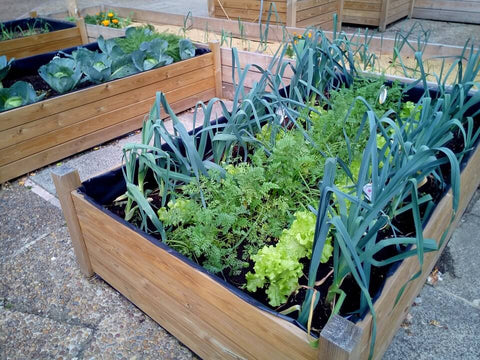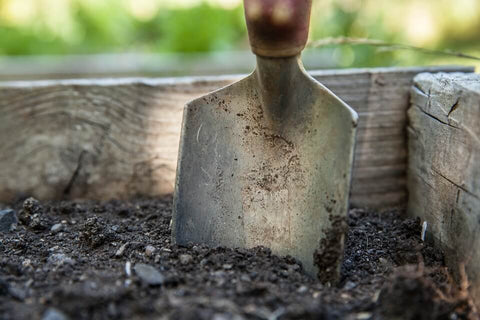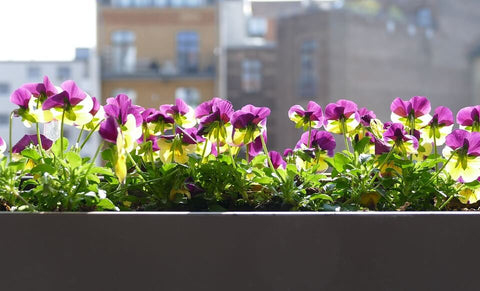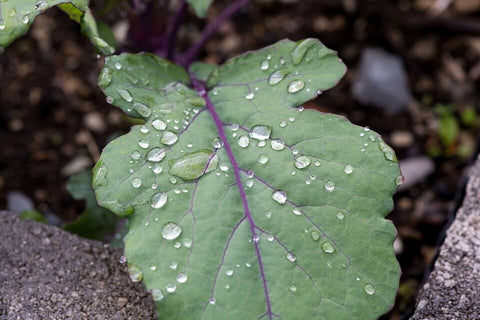Therefore, the residents of this modern, fast-paced city are conforming to terrace gardening to feel closer to nature from the comfort of their homes.
Let’s start with the basics first. What is a terrace garden, you ask? The definition of a terrace garden is quite literal. In simple terms, a kitchen garden that you grow on the roof, terrace or balcony of your house is known as a Terrace Garden. Obviously, a terrace garden in a city like Bangalore would not be as natural as the one you would grow on the ground in your backyard. There is also a limitation in terms of the plants that you can grow in a terrace garden, simply due to the lack of space.
However, terrace gardening in Bangalore can be done on almost all kinds of buildings such as residential flats, individual houses, commercial centres, factories, and godowns. The only prep you need to do is a simple waterproofing of the roof. The best part, you don’t need any agricultural knowledge to grow your own terrace garden. You only need to have a passion for it and the willingness to get your hands dirty. Moreover, a terrace garden takes as little as a week to set up and you can reap the benefits within a month from planting your first plant.
A well-planned that is managed to perfection can yield 25kg to 50kg of produce from 1 sq.m. area per year. Isn’t that amazing? And, the cost of establishment for a basic roof-top garden of 30ft x 40ft is a nominal Rs.10,000 to Rs.12,000. This is the most efficient way of having a lifetime supply of fresh and healthy produce.
Bangalore Climate and Soil Requirements

Climate - Bangalore enjoys a tropical savanna climate with very distinct wet and dry seasons. Due to high elevation from the sea level, the climate is moderate throughout the year. Despite the pleasant climate all year round in this concrete jungle, you will need to check the seasons in which you can grow certain plants to ensure that the plants don’t die.
Min. Temperature - 15.1°C
Max. Temperature - 35°C
Soil Prep - The soil in Bangalore ranges from Red Laterite to Red, fine loamy and clayey. Red soil is extremely rich in iron which is good for some plants like red gram, Bengal gram, green gram, groundnut, and castor seeds. But, this kind of soil will need additional elements to make it suitable for all kinds of vegetables or fruits that you are planning to grow in your terrace garden. Whether you are growing crops in a field or planting microgreens in the comfort of your backyard, nutrients are the most important ingredient for a good yield. Our advice is to use organic fertilizers and home-made compost always to nurture the plants.
Kitchen waste, dried leaves or animal manure is the most beneficial ingredient to make compost at home. A good potting mix helps to keep the soil moist and well-drained for the right amount of air circulation.
What are the benefits of terrace gardening in Bangalore?
Compact yet rewarding, a terrace garden is the best way to save a significant amount of money on fresh produce since it is easily accessible on your roof-top. Besides giving good quality yield, a terrace garden can be beneficial in so many other ways as well. Listed below are some of the ways a terrace garden in Bangalore could be advantageous. A terrace garden -
- Keeps the temperature cooler.
- Helps in rainwater harvesting.
- Brings you closer to nature.
- Makes your house look more visually appealing.
- Helps in reducing pollution.
- Yields fresh and organic produce.
- Allows you to grow medicinal herbs and plants at home.
What kind of vegetation can I plant in my terrace garden?

Isn’t it fascinating that you can grow at least 6 vegetables per season wherein 1 sq.m. of your terrace area can give you a yield of 25kg to 50kg in a year? Moreover, you have a wide variety of pots and containers to choose from. You can hang small containers along the wall which can be great for growing herbs. Or you can keep pots and containers of various sizes on the flat surface of your terrace to grow different types of vegetables and herbs. But be careful while selecting a tap root plant to grow on your roof-top since these kinds of plants can penetrate and harm the roof.
Let’s take a look at the sundry of fruits, vegetables, flowers, and herbs that you can grow while terrace gardening in Bangalore.
| Vegetables | Herbs | Fruits | Flowers | ||
|---|---|---|---|---|---|
| Annual | Perennial | Annual | Perennial | ||
|
Beans Beetroot Bitter Melon Carrot Bottle Gourd Cucumber Eggplant Okra Onion Peas Potato Radish Spinach Lettuce Zucchini |
Capsicum Chilli Pepper |
Coriander Fenugreek Garlic Basil Carom Dill Parsley |
Ginger Saffron Holy Basil Thyme Turmeric Rosemary Mint Curry Leaves Indian Sorrel Lemon Grass |
Strawberry Blueberry Fig Tomato Pineapple Cantaloupe Banana Watermelon Currant Gooseberry Passion Fruit |
Petunia Geranium Begonia Lobelia Pansy Impatiens Chrysanthemum Dianthus Fuchsia Zinnia |
What are the basic requirements to start terrace gardening in Bangalore?

Pre-planning is key when you are thinking of setting up a garden that will give you a good yield of produce all year round. We’ve made a list of the basic things that you require before you get your hands dirty.
- Make sure your terrace or roof-top has enough sunlight along with some shady spots.
- Easy access to water is a must for watering the plants and keeping the area clean at all times.
- In the tropical and subtropical areas like Bangalore, getting a shade net would be extremely beneficial.
- Get enough trellis or poles for the vegetables such as creepers and climbers that need support to grow.
- Gather all your gardening tools like gloves, spades, wedges, shovels, hedge shears, and others used to mix soil, trim or prune, cut leaves & branches and to harvest the produce.
- It’s also important to know which plant goes in what container. You don’t want to plant a tree in a small container and have its roots spreading in all directions, breaking the pot.
- For climbers, get large containers of at least 2x2x1 ft in size. Whereas, wide boxes with a depth of 6-12 inches would be perfect for short, leafy vegetables. Perennial plants like papaya and banana, on the other hand, which grow to be tall trees require containers with a depth of at least 5-6 ft.
Lastly, make sure that you get enough seeds of the plants you want to grow in your terrace garden. You can choose from a wide variety of vegetable, fruit, and herb seeds at AllThatGrows.
How to start terrace gardening in Bangalore?

Now that you have gathered all the supplies to set up your terrace garden, let’s begin gardening.
- Be prepared to give time to your terrace garden. It will need as much love and care as possible.
- The fun part about gardening is getting your hands dirty. Don’t be scared of the soil and its inhabitants.
- You will come into contact with a lot of insects, bugs, pests, birds, and animals who also want to enjoy the yummy fruits and vegetables from your garden.
- Chalk out a plan of action for the types of plants that you want to grow. Execute this plan by arranging them in a way that you utilize the maximum space on your terrace.
- Failure is a part and parcel of life. Gardening is no different. Don’t give up if you don’t see things pan out as you imagined it would. Some reasons for failure could be overwatering, excessive manuring, overcrowding plants, inadequate watering, or insufficient manuring.
- Prep doesn’t just consist of collecting the necessary items, but also some research work. Do thorough research on gardening tips and tricks, watch youtube videos and find out what method of gardening suits you the best.
- We know the plants in your terrace garden are like your kids and you have put a lot of time, care and love into them. It may be difficult for you to part ways with even a single sapling. But, don’t be disheartened. It’s okay to discard any plant that may have an infection from pests and insects. You can try to fix the problem. But if you are unable to do so, discard that plant so that it doesn’t affect the other plants in your garden.
What is the most effective way of watering a terrace garden?

Do you remember the most basic biology lesson that we were taught in school? Just like we need food and water to grow and survive, plants need sunlight and water to grow and survive. It is crucial to monitor the sunlight and water intake of plants because any discrepancy in the amount of sunlight or water can lead to the death of plants. Listed below are key points that you need to always keep in mind while watering your terrace garden.
- Avoid overwatering since it hinders the aeration process in the roots. Let the soil absorb the water as per its requirements. The excess water will drain out of the drainage hole.
- The most efficient way to water your plants is by using a bucket and mug. This helps to control the amount of water poured into the pots & containers and also helps to save water.
- You can also recycle the water that you have used for household chores. Except for toilet water, every form of domestic water can be used to water the plants. Even soapy water, which can provide a lot of essential nutrients, can be collected in a separate container and used.
- In addition, excess buttermilk, sambar, etc. can be used to water your plants. This reduces the waste generated from your household and also solves the problem of water shortage.
- To reduce the evaporation of water, you can add grass, waste paper, dry leaves, and other biodegradable waste to the bottom of the plants.
- Mixing water-holding gels or granules such as polymers in the potting mix will reduce the need for frequent watering since these gels absorb water and release it into the soil as it dries up which keeps your plants well hydrated for days.
- Mornings are the best time to water your terrace garden. It allows the process of photosynthesis to take place in the best possible conditions, with both sunlight and water available.
- Do not spray the foliage as it will attract more pests and insects. And if you must spray the foliage, make sure you do it early in the morning so that the leaves dry up throughout the day.
- During the summer months, make it a habit to water the plants at least twice a day with cool water.
- In winters, however, watering once every couple of days will be enough since the soil retains moisture for a longer period when the weather is cool.
- Rains are the perfect source of fresh water for the plants. And the best part, you don’t need to water them when it is raining.
Any garden is a welcoming place for one and all. So, don’t expect to invite your friends and family over. There will other uninvited guests that will pay your beautiful terrace garden a visit occasionally. Ants, mealybugs, and plant flies are just a few of them. Birds and animals would also want to have their share from your delicious produce. Don’t worry, these can be dealt with easily using pesticides. At AllThatGrows, we always recommend using organic pesticides since they are not harmful to your plants. Some organic pesticides that can be made with ingredients readily available at home could be -
- Neem
- Salt Spray
- Mineral Oil
- Citrus Oil & Cayenne Pepper
- Soap, Orange Citrus Oil & Water
- Eucalyptus Oil
- Onion & Garlic Spray
- Chrysanthemum Flower Tea
- Tobacco Spray
- Chile Pepper & Diatomaceous Earth
For the birds and animals, you can get a wire mesh or a garden shade to protect your plants. Regardless of the kind of pests in your garden, you will need to invest time into maintaining your terrace garden.
So, gather your supplies, put on your gardening gloves, get your hands dirty, and create the perfect terrace garden for yourself. You can share some of the yummy goodness from your garden with the birds and animals that drop by to visit.


 Sign In
Sign In









Comments
Great to know the facts of terrace gardening. Let me know where to buy vegetable planting pots….
Nice article. Can we reuse the soil which was used for earlier crops? Or you suggest to use fresh soil.
Good to know the basics of terrace gardening
Hi Rajesh,
Thanks for the feedback.
We would advise you to use fresh soil while planting new crops as much as possible. This is important because crops grown earlier can soak up all the nutrients in the soil and you may face germination issues or growth issues with the new crops.
Repurpose the old soil to make compost for your garden.
Hope this helps!
Thanks & Regards
Team “AllThatGrows”